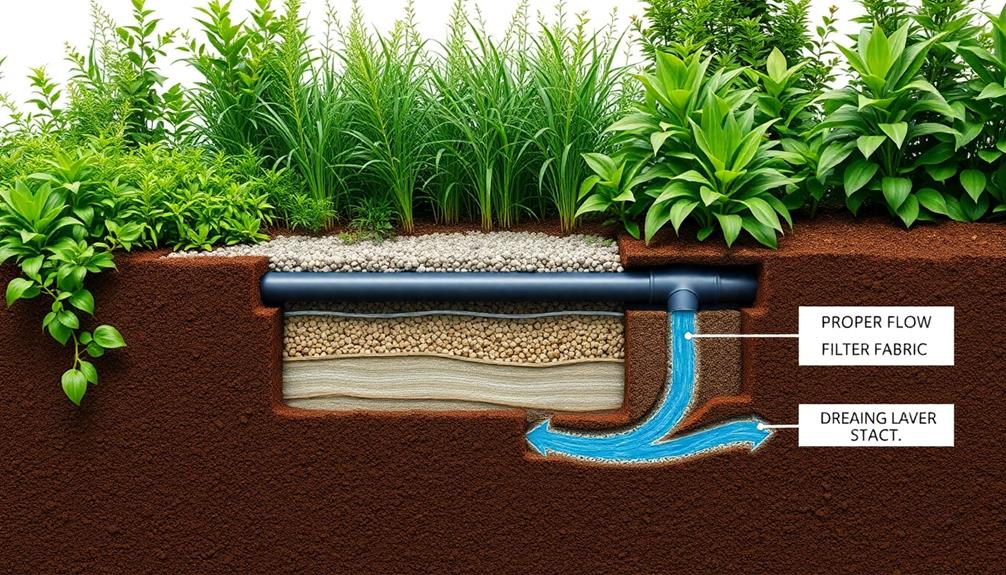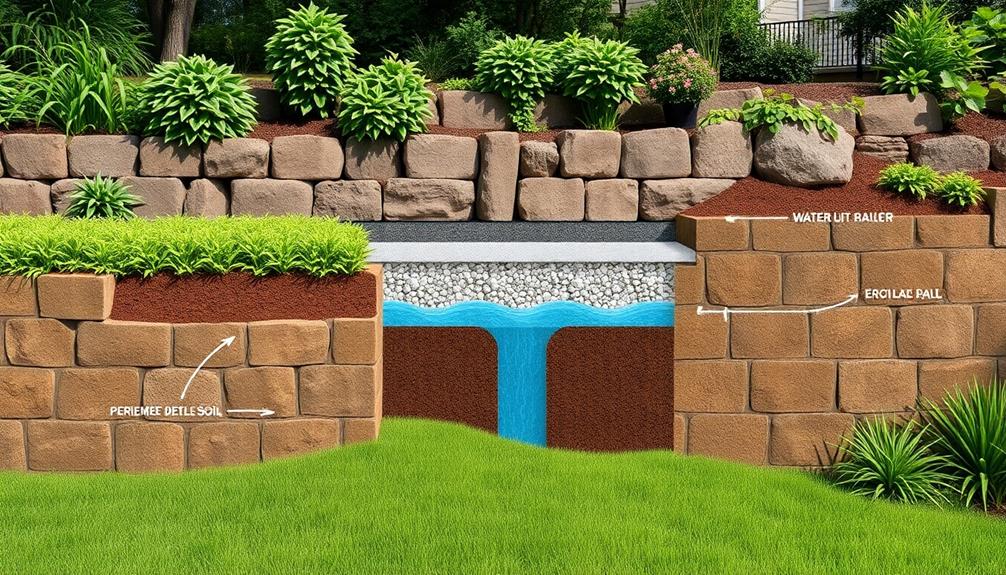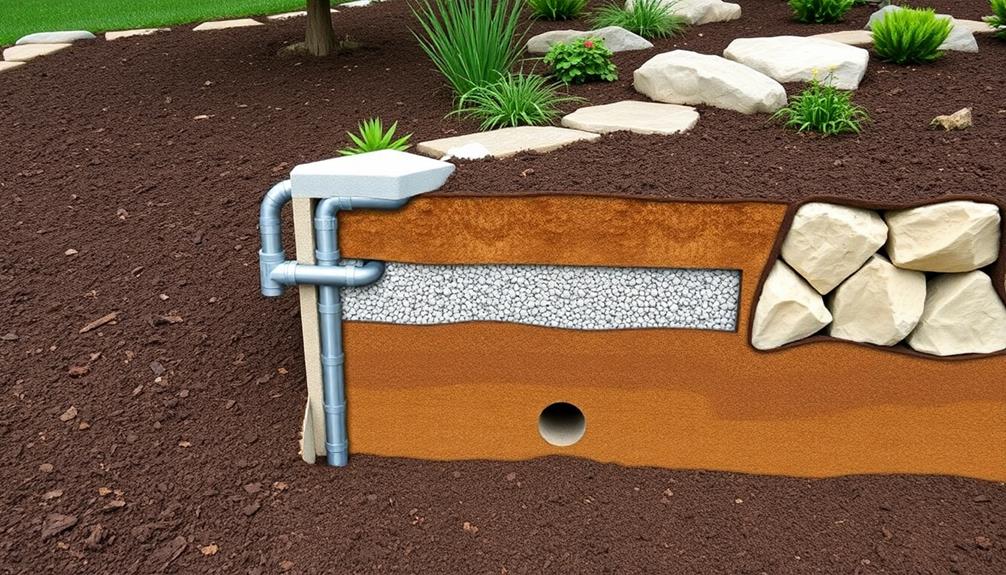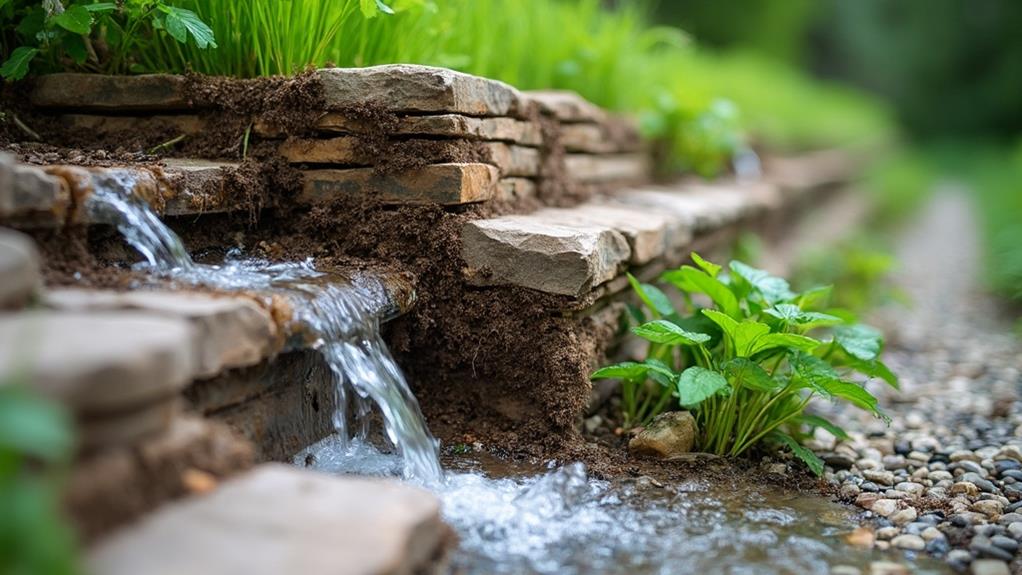Understanding retaining wall drainage systems is fundamental for maintaining the durability and structural integrity of these essential landscape elements. Proper drainage prevents water accumulation, which can lead to bulging, cracking, or collapse, by incorporating components such as perforated drain pipes, gravel backfill, and filter fabric that facilitate water movement while preventing soil clogging. Efficient drainage systems not only mitigate erosion and lateral pressure but also enhance wall stability, reduce maintenance expenses, and preserve the natural aesthetics of the environment. Exploring the detailed aspects of drainage can greatly impact the longevity and safety of retaining walls while contributing to cost-effective maintenance strategies.
Table of Contents
ToggleWalls Contractor Highlights
- Proper drainage prevents structural failures like bulging or cracking by managing water flow efficiently.
- Components like perforated drain pipes and gravel backfill are essential for effective drainage.
- Water accumulation behind walls is mitigated with weep holes and geosynthetic materials.
- Effective drainage reduces lateral pressure, enhancing wall stability and reducing maintenance costs.
- A well-designed drainage system extends the wall's lifespan and preserves the surrounding landscape.
Retaining Wall Drainage Definition

In the construction and maintenance of retaining walls, proper drainage systems are critical to ensuring structural integrity and preventing the detrimental effects of water accumulation behind the wall. These systems not only enhance the wall's durability, but they also play a role in averting erosion on the property.
Comprising essential components such as drainage pipes, gravel layers, and filter fabrics, drainage systems work collectively to guide water away from the wall foundation. By effectively managing water flow, these drainage solutions mitigate the risk of soil erosion and hydrostatic pressure, hence safeguarding the wall's longevity and performance.
Purpose of Proper Drainage
Understanding the significance of proper drainage in retaining wall systems is essential for their stability and longevity. Retaining walls, by design, are tasked with holding back soil and accommodating substantial structural pressure.
Without an efficient drainage solution, accumulated water poses a threat, dramatically increasing the lateral load exerted on the wall. This heightened pressure can lead to structural failures, such as bulging, cracking, or even collapse. Proper drainage mitigates these risks by guiding water away from exerting strain on the wall, thereby preserving structural integrity.
In addition, effective drainage systems also contribute extensively to the wall's long-term durability. Infiltration of water into the soil behind the wall, without adequate drainage, may cause erosion, which weakens the soil's holding strength. This erosion can result in not just destabilization of the wall itself, but also in damaging the surrounding landscape.
Additionally, unregulated water flow due to insufficient drainage can lead to soil saturation, freezing in colder climates, and subsequent frost heave.
For the community of homeowners, builders, and landscapers, understanding drainage's purpose fosters a sense of shared responsibility in constructing resilient walls, all while ensuring that gardens, yards, and infrastructures remain safe and maintain their intended aesthetic appeal.
Components of Drainage Systems
Implementing an effective drainage system in retaining walls involves an in-depth understanding of its key components. These systems are designed to prevent the significant accumulation of hydrostatic pressure and safeguard long-term structural integrity, essential for any homeowner or property manager.
The primary components include perforated drain pipes, gravel backfill, and filter fabric, each playing a pivotal role in the system's function. Perforated drain pipes, typically placed strategically at the base of the retaining wall, serve as conduits for redirecting water away from the wall, alleviating pressure.
A gravel backfill, composed of clean, coarse gravel, encapsulates these pipes. The gravel assists in rapid water filtration and movement, preventing stagnation while further reducing pressure against the structure. Complementing these components is the filter fabric, which covers the gravel layer. This fabric is crucial in ensuring that soil particles do not clog the drainage pathway, thereby maintaining the system's efficacy over time.
Through this intricate balance of elements, drainage systems in retaining walls contribute to a shared vision of safety and security, fostering a sense of belonging amongst those who prioritize the integrity and stability of their environments.
Preventing Water Accumulation
Proper prevention of water accumulation in retaining walls is essential for their durability and functionality. Accumulated water behind retaining walls, if unmanaged, can exert hydrostatic pressure, which endangers the structural integrity of these indispensable constructions.
The inclusion of adequately designed drainage systems is crucial to divert water away from the walls, thereby prolonging their lifespan while enhancing their performance.
Implementing effective drainage strategies, such as installing weep holes, drainage pipes, and geosynthetic materials, is fundamental in ensuring water is efficiently managed. Weep holes allow trapped water to exit through the wall, reducing pressure buildup. Drainage pipes, when incorporated into the construction, guide water from behind the wall to a designated discharge area, maintaining stability. The use of geosynthetic materials like geotextiles can assist in separating soil particles, thereby improving filtration and drainage.
A commitment to developing robust drainage systems fosters a sense of security among homeowners and community members, reassured by the structural integrity of retaining walls. Being part of such initiatives emphasizes the significance of proactive measures in infrastructure management. Knowledge of these systems fosters a collective understanding and appreciation for their role in safer, more resilient environments.
Benefits

A well-engineered retaining wall drainage system offers numerous benefits, primarily by preventing water accumulation that can compromise the structural integrity of the wall. These systems not only help to secure the wall's stability but also preserve the natural beauty of its surroundings by reducing the risk of erosion.
Prevents Water Accumulation
Effective drainage systems are critical in preventing water accumulation behind retaining walls, which could otherwise lead to structural damage and increased maintenance costs. By directing water away from the wall, these systems guarantee longevity and integrity, thus playing a pivotal role in the safeguarding of both private and public spaces.
Knowledgeable property owners understand that water accumulation is a silent adversary, which, left unchecked, can undermine the structural efficacy of retaining walls, weakening their ability to hold soil loads effectively.
Absence of a proper drainage mechanism may result in hydrostatic pressure building up behind the wall, causing cracks, bulges, or even catastrophic wall failure. Incorporating features like weep holes, drainage pipes, and gravel backfills can efficiently mitigate this risk by allowing water to evacuate naturally, reducing pressure against the masonry or concrete surfaces. This proactive approach not only extends the lifespan of the retaining wall but also drastically reduces the potential need for frequent repairs or costly overhauls.
Implementing an effective drainage system instills confidence among homeowners and project managers alike, affirming that their investment is sound and secure. Staying vigilant and informed about such essential structures fosters a sense of belonging in a community that values ingenious, enduring, and resilient construction solutions.
Enhances Wall Stability
Incorporating advanced drainage systems is one key factor in enhancing the stability of retaining walls. Retaining walls, by design, hold back significant volumes of soil, which in turn exerts continuous lateral pressure on the wall structure.
Without proper drainage, this pressure can escalate due to water buildup, leading to potential wall failure. An effective drainage system mitigates this risk by ensuring that water derived from rainfall or irrigation is efficiently diverted away from the wall's rear surface, thereby maintaining the structural integrity of the wall.
The primary components of these drainage systems typically include gravel backfill, drainage pipes, and weep holes. These elements work synergistically to channel water away from critical stress points, preventing hydrostatic pressure from destabilizing the wall.
The strategic placement of drainage pipes and weep holes allows for consistent water outflow, effectively reducing undue stress. Additionally, the introduction of non-porous geotextiles can enhance soil filtration, thus maintaining drainage efficiency.
Integrating these precise engineering measures fosters a more stable and durable retaining wall, offering peace of mind to property owners and contributing to the cohesion of communities that depend on sound environmental and structural management.
Reduces Erosion Risk
Although retaining walls are primarily designed for structural support, they also substantially reduce the risk of erosion when equipped with proper drainage systems. Erosion is a natural process where soil is displaced due to water flow, wind, or rain, potentially threatening the landscape and stability of the environment. A well-designed drainage system allows water to pass through or exit a retaining wall, effectively preventing water accumulation and the subsequent loosening of soil particles. By maintaining soil integrity, these drainage systems protect against the gradual yet insidious wear of the landscape, fostering confidence within communities that their environments continue to be secure.
Adequate drainage within the retaining wall plays a pivotal role in managing surface runoff and redirecting water away from vulnerable areas. This redirection of water helps to control the soil moisture content, minimizing the risk of landslides or significant soil displacement. Communities familiar with the challenges posed by changing weather patterns and terrain irregularities will appreciate the foresight in including a drainage system specifically designed to address such challenges. Properly installed, these systems guarantee not only physical security but also a sense of unity among community members, who can collectively enjoy a landscape that remains beautiful and stable over time.
Improves Soil Drainage
One of the primary benefits of a proper drainage system within a retaining wall is the remarkable enhancement of soil drainage. By facilitating the efficient removal of excess water from the soil, these drainage systems contribute greatly to the stability and longevity of the retaining structures. By channeling water away from the wall, they minimize water logging, which can otherwise lead to increased hydrostatic pressure, negatively impacting the wall's integrity and surrounding landscapes. Adequate drainage promotes ideal soil conditions, which are essential for preventing the disastrous consequences associated with water accumulation, such as landslides or structural failure.
Beyond structural integrity, improved soil drainage within retaining wall systems fosters an environment conducive to healthier plant growth, thus creating vibrant green spaces that communities can cherish. The reduction of excess moisture not only alleviates potential stress on plant roots but also enhances aeration, essential for nutrient uptake. This balance aids in maintaining healthy biodiversity in landscaped terrains, attracting a wide array of flora and fauna, which adds to the collective aesthetic and ecological value of the area. In this holistic approach, retaining wall drainage systems play a pivotal role in building sustainable environments, aligning with the community's shared values of beauty, safety, and environmental stewardship.
Installation Cost Considerations

When considering the installation cost of retaining wall drainage systems, it is crucial to account for a range of factors, including the expenses associated with materials and labor, which can vary significantly based on the complexity of the installation and the quality of the materials used. Additionally, long-term maintenance costs should not be overlooked, as they can impact the overall financial commitment required to guarantee the drainage system remains effective and free from obstructions. Correspondingly, regional price variations must be considered, with local market conditions influencing both the availability and cost of specialized labor and materials, effectively shaping the overall budget.
| Factor | Initial Cost Impact | Ongoing Cost Impact |
|---|---|---|
| Materials | High | Medium |
| Labor | Variable | Low |
| Maintenance | Low | Medium to High |
| Regional Variations | Medium | Variable |
| System Complexity | High | Medium |
Materials and Labor Expenses
Proper installation of a retaining wall drainage system necessitates careful consideration of both materials and labor costs. Selecting the appropriate materials is paramount, as these will drastically influence both the integrity and sustainability of the system.
Common materials include perforated pipes, gravel, and fabric filters, each contributing to the efficient removal of water from the wall's foundation. Perforated pipes facilitate guided water flow, while gravel guarantees proper drainage and fabric filters avert soil infiltration that could compromise system efficacy.
Simultaneously, labor expenses encompass the expertise required to implement these materials effectively. Hiring skilled professionals assures meticulous construction, avoiding potential pitfalls such as inadequate slope or improper pipe placement, which could lead to structural failures.
The skilled laborers' understanding of soil types, climate conditions, and wall designs further informs the nuanced execution of drainage systems, leading to a durable and reliable structure.
As community members seek to safeguard their investments in retaining walls, comprehension of these installation cost considerations provides peace of mind. Opting for quality materials and expert labor establishes a robust foundation, fostering a sense of security through adherence to best practices in construction while nurturing a shared commitment to enduring and resilient infrastructure.
Long-term Maintenance Costs
A critical aspect of retaining wall drainage systems is understanding the long-term maintenance costs associated with their installation. Regular maintenance is indispensable to guarantee these systems perform optimally, preventing soil erosion and water damage.
Maintenance costs can vary significantly depending on the material of the retaining wall, the complexity of the drainage setup, and the environmental conditions it faces. Generally, these systems require periodic inspections to identify potential issues such as blockages, sediment buildup, or damage from environmental factors.
The cost implications of neglecting maintenance can be substantial, as system failures may lead to costly repairs or even complete wall reconstruction. It is essential to factor in the labor and materials needed for occasional repairs and cleaning when calculating the total cost of ownership. Efficient drainage systems often include filter fabrics, gravel, and perforated pipes, all of which need to be maintained to ensure they continue to function effectively.
Emphasizing preventive maintenance can greatly reduce unforeseen expenses. Establishing a routine maintenance schedule with a qualified professional can help anticipate and address issues before they escalate, fostering a sense of security among property owners and ensuring the longevity of the retaining wall drainage system.
Regional Price Variations
Installation costs for retaining wall drainage systems can vary considerably from one region to another, influenced by several key factors. These variations are largely attributed to differences in labor costs, availability and cost of materials, as well as regional environmental conditions which may necessitate more sophisticated drainage solutions.
For instance, urban areas with higher living costs tend to have elevated labor prices, impacting the overall installation expenses. Moreover, the availability of specific materials can fluctuate based on geographical location, affecting supply chain logistics and ultimately pricing.
Additionally, climatic conditions play a significant role; regions prone to heavy rainfall or with challenging soil types require tailored solutions to guarantee optimal drainage and stability, potentially increasing cost. Engaging local professionals familiar with the native landscape and climate is indispensable to achieving efficient outcomes. This not only assures regulatory compliance but also that the system performs efficiently under regional weather patterns.
For community members invested in property or land, understanding these regional disparities allows for informed decision-making, ensuring a sense of assurance that they are investing wisely in sustainable and effective infrastructure. Joining a network of knowledgeable peers and professionals aids in maneuvering these complex considerations, fostering a communal sense of shared success.
Walls Contractor FAQ
How Do Retaining Wall Drainage Systems Prevent Water Damage?
Retaining wall drainage systems prevent water damage by effectively channeling water away from structures, thereby mitigating hydrostatic pressure buildup. This safeguards structural integrity, fostering community resilience in shared environments where safety and cohesiveness are pivotal values.
What Are Common Maintenance Tips for Retaining Wall Drainage Systems?
Regularly inspect drainage outlets for blockages. Guarantee the gravel backfill is intact, fostering ideal water flow. Clean weep holes periodically. Maintain vegetation control to prevent root intrusion. Engage in community knowledge-sharing to guarantee system longevity and effectiveness.
Can Poor Drainage Systems Affect the Lifespan of a Retaining Wall?
Poor drainage systems greatly impact the lifespan of a retaining wall by increasing hydrostatic pressure and promoting erosion. This community can achieve longevity by ensuring proper drainage, fostering a sturdy foundation, and preserving the wall's structural integrity.
Are There Eco-Friendly Options for Retaining Wall Drainage Systems?
Eco-friendly drainage options for retaining walls include using permeable materials, rain gardens, and natural vegetation. These approaches foster environmental stewardship while effectively managing water drainage and enhancing the structural longevity, consequently aligning with sustainable community practices.
How Do You Troubleshoot Issues in a Retaining Wall Drainage System?
To troubleshoot retaining wall drainage system issues, examine for clogs or blockages, inspect outlet pipes for proper water flow, and assess the gravel for compaction issues. Regular maintenance guarantees optimal function, fostering a sense of community safety and reliability.







